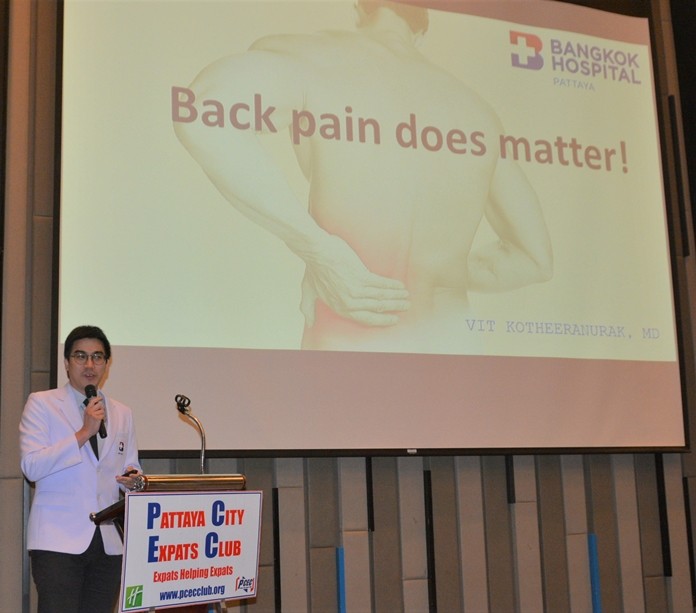
Aching backs were the topic of discussion at the September 15 meeting of the Pattaya City Expats Club. The guest speaker was Dr. Vit Kotheenranurak, an Orthopedic Surgeon from Bangkok Hospital Pattaya. His presentation was a clear and informative talk about lower back pain and its treatment through exercise, physical therapy, medication, and surgery dependent upon its cause. He provided many photos and diagrams to fully explain the types of lower pain back, what can cause it, and the methods available to treat it including the latest surgical techniques, if needed.
Doctor Vit explained that about 80 percent of the population will experience lower back pain one or more times in their life time. So, this condition will impact most people as some point. The severity, location, and duration can offer clues as to the cause, but often will need diagnostic tools such as Magnetic Resonance Imaging (MRI). Lower back pain can often be treated using exercise, physical therapy and/or medication. But, if these treatment methods are ineffective, and you have pain or numbness in the legs, or it is limiting your ability to walk or do other activities, then surgery may be indicated. Two types of conditions often are the cause of lower back pain; a herniated disk or lumbar spinal stenosis.
A herniated disk (also called a bulging, protruding, or ruptured disk) is when one of the disks between individual bones in the vertebrae may push all the way through the disk’s outer ring or cause the ring to bulge; this puts pressure on the spinal cord and nearby nerve roots. When asked what causes disk herniation generally, Dr Vit replied that there were multiple factors that bear on the cause such as work environment, aging, genetics, lifestyle, etc. To help prevent a herniated disk, you need to have proper posture and do exercises to strengthen trunk muscles to help support the spine.
Lumbar spinal stenosis is a narrowing of the spinal canal, compressing the nerves traveling through the lower back into the legs and is more often associated with a degenerative condition that affects people who are typically age 60 and older.
He emphasized that you should maintain good posture as it reduces the pressure on your spine and disks. He mentioned using a proper sitting position as well as some other everyday things that we do that have an impact on preventing. He said you need to have the correct posture for your body. When you sit you need to have full support for your back. Also, you should not sit for a long time, take breaks to stretch with every 30 minutes being the best and then go back to sitting. In addition, Dr. Vit showed the proper posture for picking up items, walking and surprisingly how to sleep with your legs elevated to minimize pressure on the lower back.
Often, physical therapy and/or prescribed exercises may help to stabilize the spine, build endurance, and increase flexibility. Such therapy may help the patient to resume normal activities. Dr. Vit explained that if it is suspected that the back pain is caused by a nerve which could also be causing leg pain as well, then a full detailed image of the nerve root may be needed. MRIs are a very helpful diagnostic tool in such cases, as X-rays and CT scans do not show if a nerve is the cause of the pain.
If surgery is considered, Dr. Vit said Endoscopic Surgery can often be used. He described the procedures and the benefits of this type of surgery. The Endoscope Surgery procedure was shown in detail including before and after photos of patients which gave a strong visual impact as well as providing a clear understanding of lower back pain and the surgical procedure to mitigate the condition. He pointed out that the Endoscope Surgery procedure, which is a minimally invasive process, is becoming a standard procedure because it requires a very small wound, you only need to stay in the hospital one day, so it is not considered a big surgery anymore. Further, it causes minimal damage to the surrounding tissue, reducing recovery time, pain and risk to the patient.
After the presentation, the MC brought everyone up to date on upcoming Club and other Pattaya events of interest. The meeting ended with the usual Open Forum where audience members can ask questions or make comments about expat living in Thailand, especially Pattaya.
Member Ren Lexander interviewed Dr. Vit Kotheenranurak after his presentation to the PCEC. To view the video, visit: https://www.youtube.com/watch?v=fTsJgjm0nHE&t=47s
For more information about the PCEC, visit their website at http://pattayacityexpatsclub.com/.
 |
 |
 |





